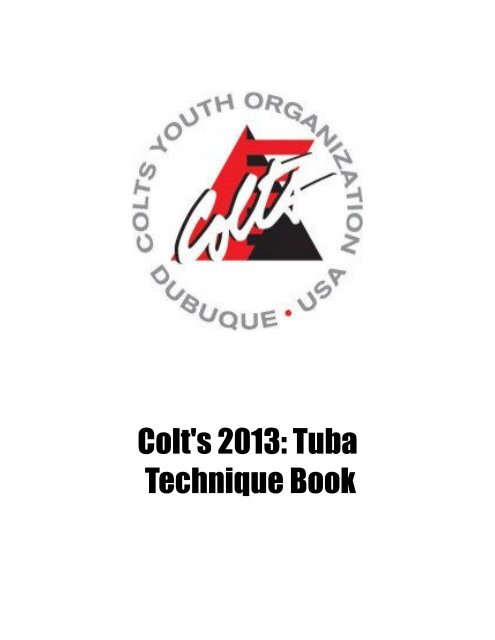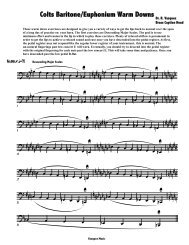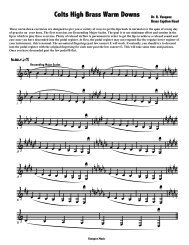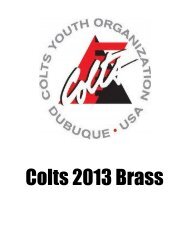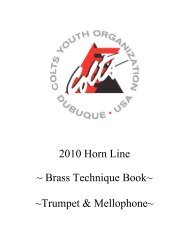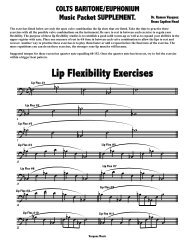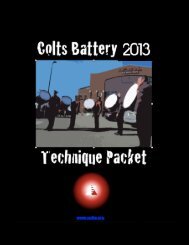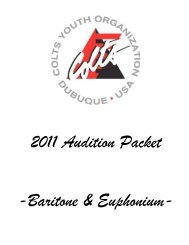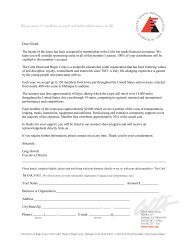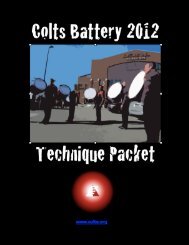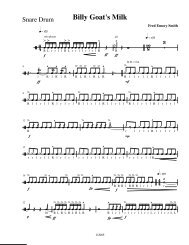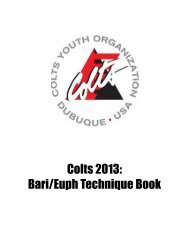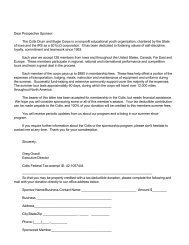You also want an ePaper? Increase the reach of your titles
YUMPU automatically turns print PDFs into web optimized ePapers that Google loves.
Colt's 2013: <strong>Tuba</strong><strong>Technique</strong> <strong>Book</strong>
The purpose of this booklet is to provide a guideline of the technique and skills needed for the2013 <strong>Colts</strong> brass line. The series of exercises that follow model a specific set of skills thatapply to the brass program. You should consider the entire series of exercises as a pyramid that stackseach skill onto the next, starting with the first exercise:BreathingThe execution of the breath should be elementary and paramount. It shouldn't be something thatis dissected, but rather a natural action of something you've been doing well, and efficiently, since birth.There is such a thing as over thinking. So try not to dwell on this. Just take a relaxed, full, open breathand you won't have problems. At all times, avoid tension in the breath. It will translate to the horn.Creating a soundAfter you take your first breath, keep that open sensation in your throat and mouth the same. Setyour lips together and move air to initiate a buzz. This is called an “Air attack”. Unless otherwisespecified, we will always use this form of “articulation” or, rather, lack thereof.ArticulatingIf you exhale your air and imagine it a water faucet, articulating would be interrupting the flowof the water (or rather, the air). Depending on the style, an articulation technique might change, but thegenerally accepted technique is similar to the saying the syllable “Dah”. The tongue strikes above theteeth and immediately drops out of the way.Exercises:8 count tonesA warm-up standard. Stand up tall. Relax. Pick a tempo. Take a deep breath. Set yourembouchure and go! Strive for a steady sound throughout the phrase. Blow air through the note, not ATthe note. At the end of each note, end with an inhale to stop the sound rather than stopping the air withyour tongue or throat. This will allow the note to ring, as opposed to just falling out of your instrument.This is called a “Breath Release”This exercise can be done in several partials. The point is to make the best possible sounds at the startof your day. Getting your face to start “waking up”. Like stretching for your face.Low Slur:Here, we introduce the slur (still without articulating). The idea is to move from one note to thenext as smoothly as possible. This requires a very direct airstream and a changing of the air flow fromone speed to another instantly. In this instance, it's going from a higher note (concert F) with faster air,to a lower note (concert Bb) with slower air. Remember, quick air changes and direction in that air!
This exercise can be played in reverse to work on an air change from low speed to higher speed.Quarters High/Low:This is a middle-range slur working on both slur directions. Keep in mind that the slurs are nowgetting faster. Strive to make the changes instant so that, no matter the speed, they can still be clearEighths Low and High:As you can see, the slurs get more intricate as you progress through your warm-up. We don'texpect you all to be able to do these perfectly yet. These are exercises for a reason, they're supposed tobe difficult. This is why we practice.
Articulation Study 1.Here we have our first series of “un-slurred” notes. These studies are generally used to just getyour articulations moving at the start of your day. By defining a specific style to the exercise you workon a specific skill set that should relate to a similar style in show music. For this study, we will cyclethrough with several different styles (legato, staccato, marcato, accent, etc..)Often, the most identifying part of the articulation is the treatment of end of the note. So thisexercise isolates the silences and ends of notes.Articulation Study 2However, there can be space between notes without a written rest. Our treatment of “connected”notes will be a sign of maturity, or immaturity if done poorly.Tuning:This is really the act of being aware of ourselves and how we relate to others. Starting with thethings you can control, lets talk about individual tuning. Your intonation can be affected by the slightestchange anywhere in your body. If you raise your eyebrows, you're likely to push sharp unless you areaware of your pitch center at all times. What does that mean? If you aren't playing right down thecenter of your horn, you will alter your pitch. Any work done to tune you is a waste of time if you don'thave a solid hold on where the center of your horn, sound, and pitch is.Now, there are times when we NEED to alter our pitch from center in order to be in tune withthe ensemble. For example, in a major chord, if you play the third of the chord you need to play 14cents flat in order to play a proper major triad in tune. The act of altering our pitch center is a littletricky. Do it the wrong way and it will alter our sound in a negative way. We must understand thefundamentals of “pitch bending”.Pitch Bending:Pitch bending is a fancy way of saying forcing yourself to play sharp or flat. The way we do thisis by re-shaping our embouchure slightly. In the exercise below, we essentially bounce from concert Bbto progressively lower pitches. First time through, we will use valves but the second time we will pitchbend to reach each note. Roll your bottom lip SLIGHTLY out to bend down, and roll in to bend up.This angles the airstream slightly higher or lower to produce the desired pitch change. When you bend
ack to concert Bb, center in on that pitch before moving to the next. This exercise will often be donewith two groups. One playing a sustained Bb, the other doing pitch bends.Chord Tendencies:Each chord has it's own pitch tendencies and necessary pitch alterations. Here is a list ofcommonly occurring chords and their alterations. In this first chart, the notes and their alterations relateto a tonic C in both major and minor.Different Chord StructuresIn most of the classical canon, we really only run into a few of these chord structures. Major,Minor, Dominant 7s, diminished (7s). The rest are structures of jazz or modern compositionaltechniques and will be rare in the drum corps setting. Nevertheless, this is a good piece of informationto have for drum corps and music in general. Knowing the type of chord you are playing and where youstand in said chord is an important facet of professional musicianship.
Putting it Together:It is easy to get lost in the monotony of fundamentals. The best way to remedy this is to applythe skills you've practiced to actual music (we are here to play music, after all). Here is a short Bachchorale arranged to pool all your skills into a single exercise. Note that there aren't articulations given,so this can be defined as a variety of different styles. The arranger has also kindly noted which part hasthe 3 rd , the 5 th , or the 7 th of the chord so you know how to adjust accordingly. Prepare to play this in amultitude of ways. All slurred, bopped, pppp, sung, on mouthpiece etc.


